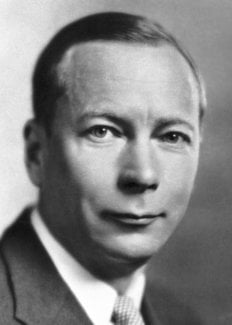Henrik Dam
Biographical

Carl Peter Henrik Dam was born in Copenhagen on 21st February 1895, to Emil Dam, apothecary, and his wife Emilie (née Peterson), a teacher.
The young man graduated in chemistry from the Polytechnic Institute, Copenhagen in 1920, and the same year was appointed instructor (assistant) in chemistry at the School of Agriculture and Veterinary Medicine, progressing to instructor in biochemistry at the Physiological Laboratory of the University of Copenhagen, 1923. The following year saw his marriage, to Inger, née Olsen.
In 1925 Dam studied microchemistry in Graz (Austria) with F. Pregl. He became Assistant Professor at the Institute of Biochemistry, Copenhagen University, in 1928, and was promoted to Associate Professor at the same place in 1929, continuing to hold this post although he was working abroad part of the time, till 1941. On submitting a thesis Nogle Undersøgelser over Sterinernes Biologiske Betydning (Some investigations on the biological significance of the sterines) to the University of Copenhagen in 1934, Dam was awarded Ph.D. in Biochemistry.
To further his studies of the metabolism of sterols, Dam obtained a Rockefeller Fellowship and worked in Rudolph Schoenheimer’s Laboratory in Freiburg, Germany, during 1932-1933, and later worked with P. Karrer, of Zurich, in 1935. He discovered vitamin K while studying the sterol metabolism of chicks in Copenhagen. He studied this vitamin further with respect to its occurrence and biological function in animals and plants, as well as its application in human medicine, its fundamental chemical and physical properties and its purification and isolation – the latter part of this research being carried out in collaboration with P. Karrer. From the study of vitamin K arose the observation of some new symptoms in experimental animals, such as increased capillary permeability and colouration of adipose tissue, which turned out to be due to the ingestion of certain fats in the absence of vitamin E.
He was on a lecture tour of Canada and the United States under the auspices of the American Scandinavian Foundation in 1940-1941, this tour having been planned before the occupation of Denmark by German troops in April, 1940. He was able to carry out research in Woods Hole Marine Biological Laboratories during the summer and autumn of 1941, and at the University of Rochester, N.Y., between 1942-1945 as a Senior Research Associate – it was during this period that he was awarded the 1943 Nobel Prize for Physiology or Medicine – and at the Rockefeller Institute for Medical Research in 1945 as an Associate Member.
During his absence, Dam was appointed Professor of Biochemistry at the Polytechnic Institute, Copenhagen, in 1941, though the designation of his Chair at the Polytechnic Institute was changed to Professor of Biochemistry and Nutrition in 1950.
After his return to Denmark in 1946, Dam’s main research subjects were vitamin K, vitamin E, fats, cholesterol, and, in recent years, nutritional studies in relation to gall-stone formation. He has been leader of the Biochemical Division of the Danish Fat Research Institute from 1956 to 1962.
He has published or has collaborated in the publication of about 315 articles on biochemical problems, mainly concerning the biochemistry of sterols, vitamins K and E, and fats.
Professor Dam is a member of the Danish Academy of Technical Sciences (1947); the Royal Danish Academy of Sciences and Letters (1948); he was Correspondant Étranger, Académie Royale de Médecine de Belgique (1951); elected Hon. Fellow of the Royal Society, Edinburgh (1953); became Joint Honorary President, International Union of Nutritional Sciences in 1954, and was Corresponding Member of the German Association for Nutrition in 1961, following on the award of the Norman Medal by the German Association for Fat Research the previous year.
This autobiography/biography was written at the time of the award and first published in the book series Les Prix Nobel. It was later edited and republished in Nobel Lectures. To cite this document, always state the source as shown above.
Henrik Dam died on April 17, 1976.
Nobel Prizes and laureates
Six prizes were awarded for achievements that have conferred the greatest benefit to humankind. The 12 laureates' work and discoveries range from proteins' structures and machine learning to fighting for a world free of nuclear weapons.
See them all presented here.
